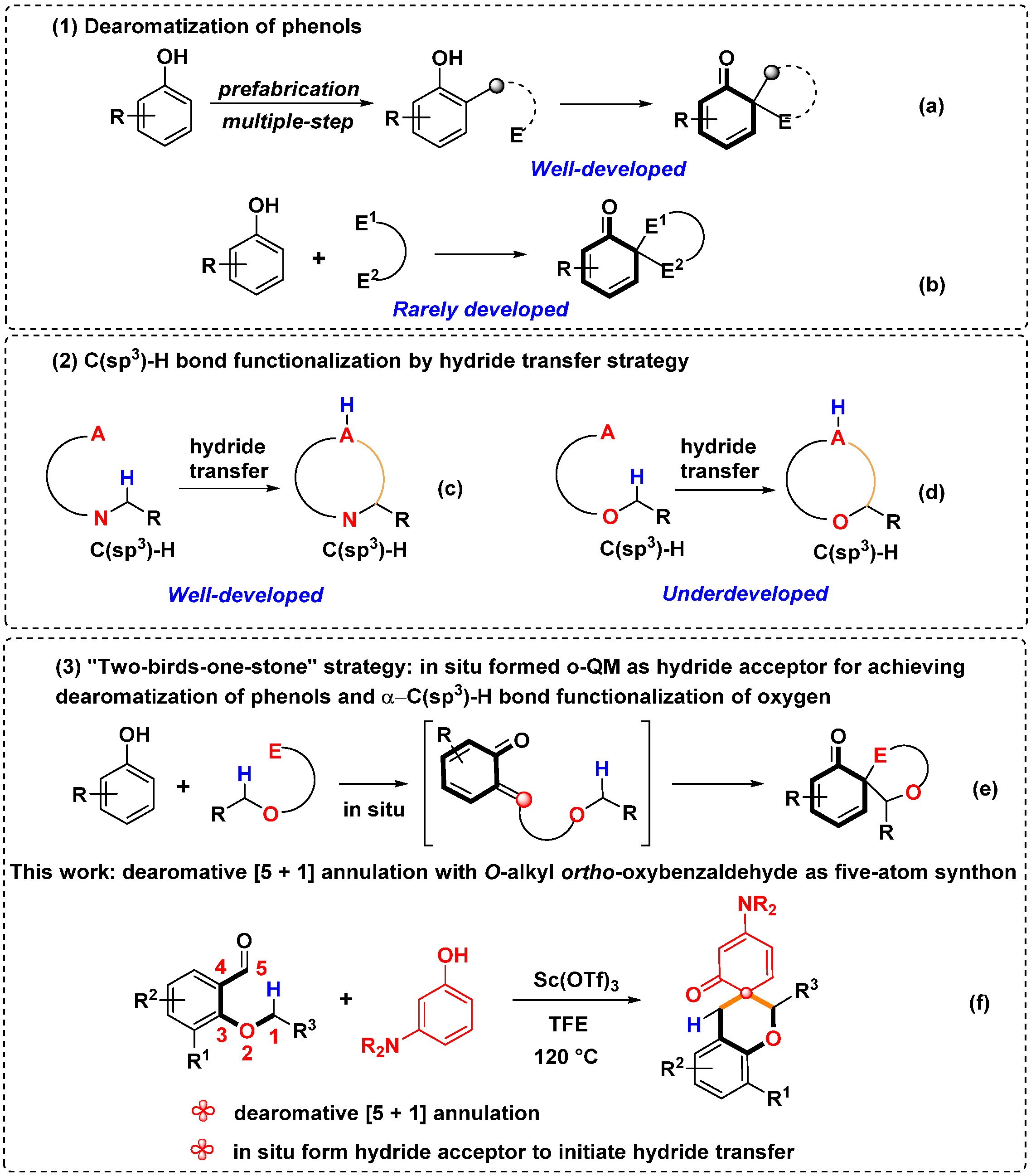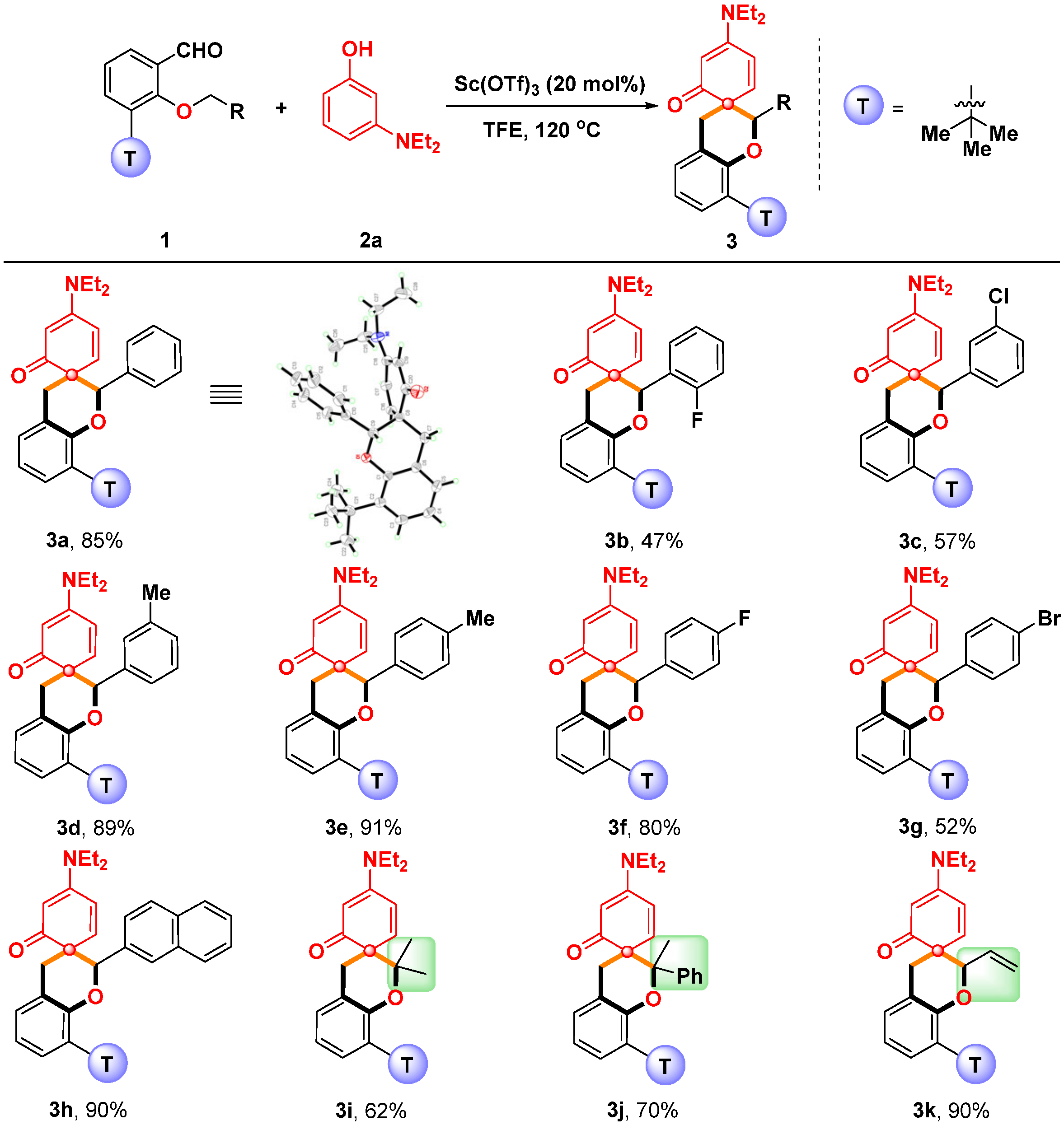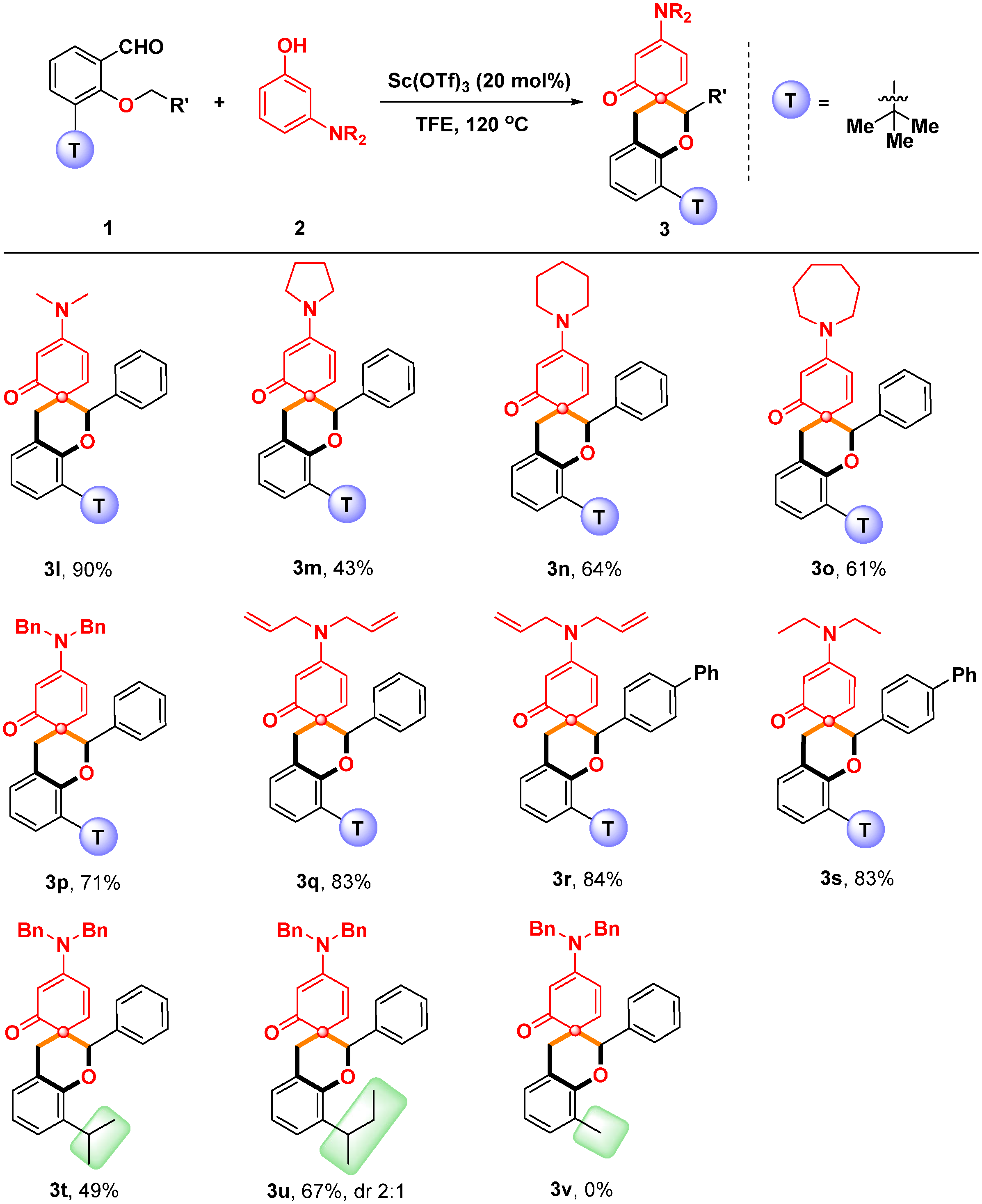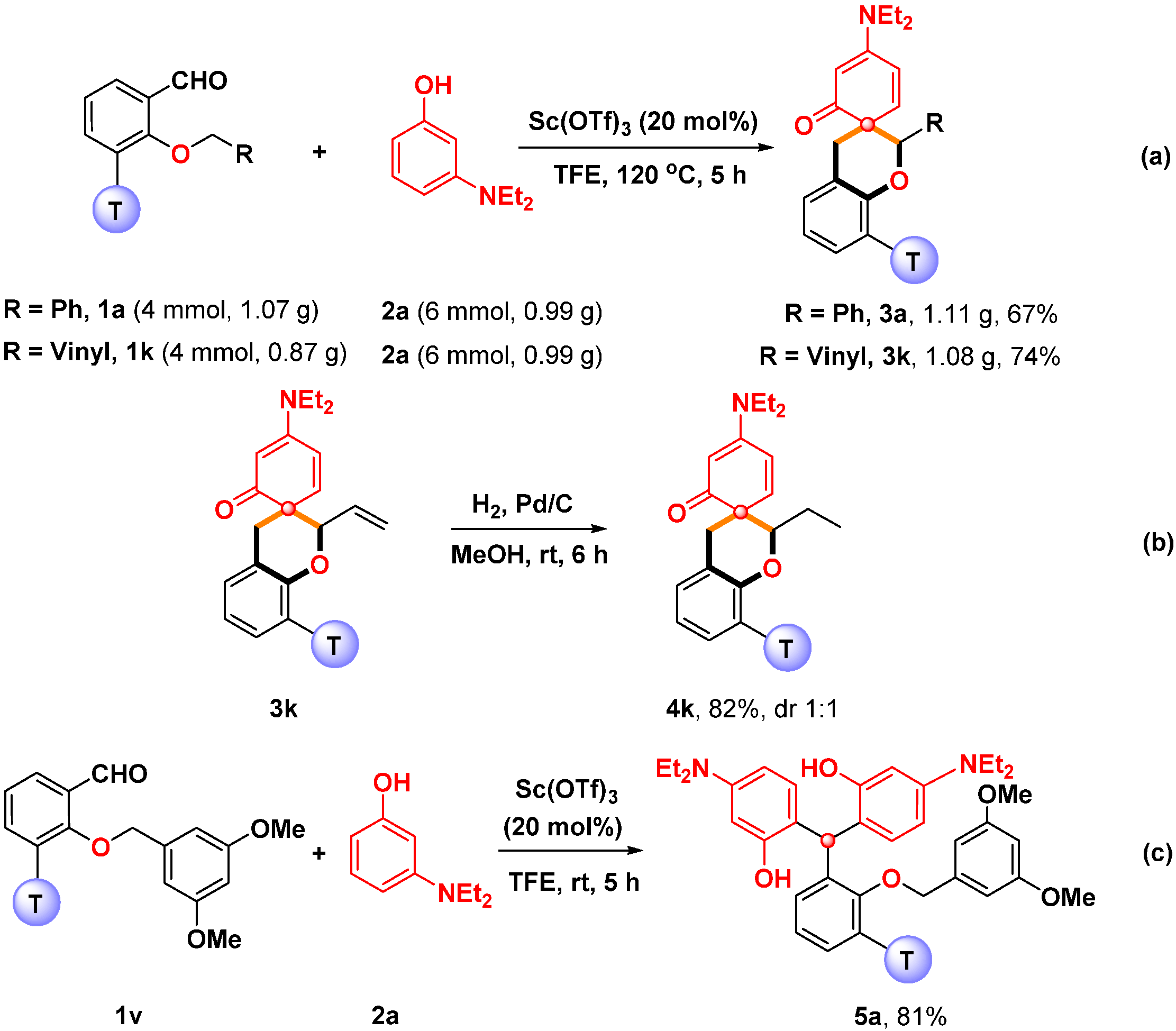Dearomatization of 3-Aminophenols for Synthesis of Spiro[chromane-3,1′-cyclohexane]-2′,4′-dien-6′-ones via Hydride Transfer Strategy-Enabled [5+1] Annulations
Abstract
:1. Introduction
2. Results and Discussion
3. Materials and Methods
3.1. General Information
3.2. General Procedure for the Dearomative [5+1] Annulation
3.3. Gram-Scale Synthesis and Derivatization of Products 3
3.4. The Procedure for Synthesis of Product 5a
3.5. Investigation on the “Buttressing Effect”
3.6. Investigation on the Effect of Hydride Donors
3.7. Characterization of Products
3.8. In Vitro Antifungal Activities
4. Conclusions
Supplementary Materials
Author Contributions
Funding
Institutional Review Board Statement
Informed Consent Statement
Data Availability Statement
Conflicts of Interest
References
- Della Ca’, N.; Fontana, M.; Motti, E.; Catellani, M. Pd/Norbornene: A Winning Combination for Selective Aromatic Functionalization via C–H Bond Activation. Acc. Chem. Res. 2016, 49, 1389–1400. [Google Scholar] [CrossRef]
- Wang, J.; Dong, G. Palladium/Norbornene Cooperative Catalysis. Chem. Rev. 2019, 119, 7478–7528. [Google Scholar] [CrossRef]
- Luckemeier, L.; Pierau, M.; Glorius, F. Asymmetric arene hydrogenation: Towards sustainability and application. Chem. Soc. Rev. 2023, 52, 4996–5012. [Google Scholar] [CrossRef]
- Cheng, Y.-Z.; Feng, Z.; Zhang, X.; You, S.-L. Visible-light induced dearomatization reactions. Chem. Soc. Rev. 2022, 51, 2145–2170. [Google Scholar] [CrossRef]
- Xia, Z.-L.; Xu-Xu, Q.-F.; Zheng, C.; You, S.-L. Chiral phosphoric acid-catalyzed asymmetric dearomatization reactions. Chem. Soc. Rev. 2020, 49, 286–300. [Google Scholar] [CrossRef] [PubMed]
- Sun, W.; Li, G.; Hong, L.; Wang, R. Asymmetric dearomatization of phenols. Org. Biomol. Chem. 2016, 14, 2164–2176. [Google Scholar] [CrossRef] [PubMed]
- Hu, F.; Shen, Y.; Wang, L.; Li, S.-S. Merging dearomatization with redox-neutral C(sp3)–H functionalization via hydride transfer/cyclization: Recent advances and perspectives. Org. Chem. Front. 2022, 9, 5041–5052. [Google Scholar] [CrossRef]
- Park, S.; Chang, S. Catalytic Dearomatization of N-Heteroarenes with Silicon and Boron Compounds. Angew. Chem. Int. Ed. 2017, 56, 7720–7738. [Google Scholar] [CrossRef] [PubMed]
- Wertjes, W.C.; Southgate, E.H.; Sarlah, D. Recent advances in chemical dearomatization of nonactivated arenes. Chem. Soc. Rev. 2018, 47, 7996–8017. [Google Scholar] [CrossRef] [PubMed]
- Wang, Y.-M.; Wu, J.; Hoong, C.; Rauniyar, V.; Toste, F.D. Enantioselective Halocyclization Using Reagents Tailored for Chiral Anion Phase-Transfer Catalysis. J. Am. Chem. Soc. 2012, 134, 12928–12931. [Google Scholar] [CrossRef] [PubMed]
- Wang, S.-G.; You, S.-L. Hydrogenative Dearomatization of Pyridine and an Asymmetric Aza-Friedel–Crafts Alkylation Sequence. Angew. Chem. Int. Ed. 2014, 53, 2194–2197. [Google Scholar] [CrossRef]
- Zhang, M.; Sun, W.; Zhu, G.; Bao, G.; Zhang, B.; Hong, L.; Li, M.; Wang, R. Enantioselective Dearomative Arylation of Isoquinolines. ACS Catal. 2016, 6, 5290–5294. [Google Scholar] [CrossRef]
- Fan, L.; Liu, J.; Bai, L.; Wang, Y.; Luan, X. Rapid Assembly of Diversely Functionalized Spiroindenes by a Three-Component Palladium-Catalyzed C−H Amination/Phenol Dearomatization Domino Reaction. Angew. Chem. Int. Ed. 2017, 56, 14257–14261. [Google Scholar] [CrossRef]
- He, Y.; Li, Z.; Robeyns, K.; Meervelt, L.V.; Van der Eycken, E.V. A Gold-Catalyzed Domino Cyclization Enabling Rapid Construction of Diverse Polyheterocyclic Frameworks. Angew. Chem. Int. Ed. 2018, 57, 272–276. [Google Scholar] [CrossRef]
- Hashimoto, T.; Shimazaki, Y.; Omatsu, Y.; Maruoka, K. Indanol-Based Chiral Organoiodine Catalysts for Enantioselective Hydrative Dearomatization. Angew. Chem. Int. Ed. 2018, 57, 7200–7204. [Google Scholar] [CrossRef]
- Dong, S.; Fu, C.; Ge, Y.; Liu, J.; Wang, H.; Luan, X. Dearomatization/Spiroannulation of Halophenols Enables the Forging of Contiguous Quaternary Carbon Cyclohexadienones. Org. Lett. 2023, 25, 7841–7846. [Google Scholar] [CrossRef]
- Dohi, T.; Takenaga, N.; Nakae, T.; Toyoda, Y.; Yamasaki, M.; Shiro, M.; Fujioka, H.; Maruyama, A.; Kita, Y. Asymmetric Dearomatizing Spirolactonization of Naphthols Catalyzed by Spirobiindane-Based Chiral Hypervalent Iodine Species. J. Am. Chem. Soc. 2013, 135, 4558–4566. [Google Scholar] [CrossRef] [PubMed]
- Nan, J.; Zuo, Z.; Luo, L.; Bai, L.; Zheng, H.; Yuan, Y.; Liu, J.; Luan, X.; Wang, X. RuII-Catalyzed Vinylative Dearomatization of Naphthols via a C(sp2)–H Bond Activation Approach. J. Am. Chem. Soc. 2013, 135, 17306–17309. [Google Scholar] [CrossRef] [PubMed]
- Zhuo, C.-X.; You, S.-L. Palladium-Catalyzed Intermolecular Asymmetric Allylic Dearomatization Reaction of Naphthol Derivatives. Angew. Chem. Int. Ed. 2013, 52, 10056–10059. [Google Scholar] [CrossRef] [PubMed]
- Haibach, M.C.; Seidel, D. C-H bond functionalization through intramolecular hydride transfer. Angew. Chem. Int. Ed. 2014, 53, 5010–5036. [Google Scholar] [CrossRef] [PubMed]
- Kwon, S.J.; Kim, D.Y. Organo- and organometallic-catalytic intramolecular [1,5]-hydride transfer/cyclization process through C(sp3)–H bond activation. Chem. Rec. 2016, 16, 1191–1203. [Google Scholar] [CrossRef]
- Shen, Y.; Hu, F.; Li, S.-S. Alkyl amines and ethers as traceless hydride donors in [1,5]-hydride transfer cascade reactions. Org. Biomol. Chem. 2023, 21, 700–714. [Google Scholar] [CrossRef]
- Idiris, F.I.M.; Majesté, C.E.; Craven, G.B.; Jones, C.R. Intramolecular Hydride Transfer onto Arynes: Redox-Neutral; Transition Metal-free C(sp3)-H Functionalization of Amines. Chem. Sci. 2018, 9, 2873–2878. [Google Scholar] [CrossRef]
- Otawa, Y.; Mori, K. Construction of Seven- and Eight-Membered Carbocycles by Lewis Acid Catalyzed C(sp3)-H Bond Functionalization. Chem. Commun. 2019, 55, 13856–13859. [Google Scholar] [CrossRef]
- Ramakumar, K.T.; Maji, J.; Partridge, J.; Tunge, J.A. Synthesis of Spirooxindoles via the Tert-Amino Effect. Org. Lett. 2017, 19, 4014–4017. [Google Scholar] [CrossRef]
- Liu, S.; Qu, J.; Wang, B. Substrate-Controlled Divergent Synthesis of Polycyclic Indoloazepines and Indolodiazepines via 1,5-Hydride Shift/7-Cyclization Cascades. Chem. Commun. 2018, 54, 7928–7931. [Google Scholar] [CrossRef]
- Zhen, L.; Wang, J.; Xu, Q.-L.; Sun, H.; Wen, X.; Wang, G. Direct Intermolecular C-H Functionalization Triggered by 1,5-Hydride Shift: Access to N-Arylprolinamides via Ugi-Type Reaction. Org. Lett. 2017, 19, 1566–1569. [Google Scholar] [CrossRef]
- Zhao, S.; Wang, X.; Wang, P.; Wang, G.; Zhao, W.; Tang, X.; Guo, M. BF3·OEt2-Promoted Propargyl Alcohol Rearrangement/[1,5]-Hydride Transfer/Cyclization Cascade Affording Tetrahydroquinolines. Org. Lett. 2019, 21, 3990–3993. [Google Scholar] [CrossRef] [PubMed]
- Suh, C.W.; Kim, D.Y. Enantioselective One-Pot Synthesis of Ring-Fused Tetrahydroquinolines via Aerobic Oxidation and 1,5-Hydride Transfer/Cyclization Sequences. Org. Lett. 2014, 16, 5374–5377. [Google Scholar] [CrossRef] [PubMed]
- Han, Y.-Y.; Han, W.-Y.; Hou, X.; Zhang, X.-M.; Yuan, W.-C. FeCl3-Catalyzed Stereoselective Construction of Spirooxindole Tetrahydroquinolines via Tandem 1,5-Hydride Transfer/Ring Closure. Org. Lett. 2012, 14, 4054–4057. [Google Scholar] [CrossRef] [PubMed]
- Wicker, G.; Schoch, R.; Paradies, J. Diastereoselective Synthesis of Dihydro-quinolin-4-ones by a Borane-Catalyzed Redox-Neutral endo-1,7-Hydride Shift. Org. Lett. 2021, 23, 3626–3630. [Google Scholar] [CrossRef] [PubMed]
- Chen, W.; Seidel, D. α-C–H/N–H Annulation of Alicyclic Amines via Transient Imines: Preparation of Polycyclic Lactams. Org. Lett. 2021, 23, 3729–3734. [Google Scholar] [CrossRef]
- Zhang, B.-B.; Peng, S.; Wang, F.; Lu, C.; Nie, J.; Chen, Z.; Yang, G.; Ma, C. Borane-catalyzed cascade Friedel–Crafts alkylation/[1,5]-hydride transfer/Mannich cyclization to afford tetrahydroquinolines. Chem. Sci. 2022, 13, 775–780. [Google Scholar] [CrossRef] [PubMed]
- Li, S.-S.; Lv, X.; Ren, D.; Shao, C.-L.; Liu, Q.; Xiao, J. Redox-Triggered Cascade Dearomative Cyclizations Enabled by Hexafluoroisopropanol. Chem. Sci. 2018, 9, 8253–8259. [Google Scholar] [CrossRef] [PubMed]
- Dong, Y.; Hu, F.; Wu, H.; Guo, F.-W.; Wang, L.; Du, F.-Y.; Li, S.-S. Controllable Synthesis of N-Heterocycles via Hydride Trans-fer Strategy-enabled Formal [5+1] and [5+2] Cyclizations. Org. Lett. 2024, 1, 332–337. [Google Scholar] [CrossRef]
- McQuaid, K.M.; Sames, D. C−H Bond Functionalization via Hydride Transfer: Lewis Acid Catalyzed Alkylation Reactions by Direct Intramolecular Coupling of sp3 C−H Bonds and Reactive Alkenyl Oxocarbenium Intermediates. J. Am. Chem. Soc. 2009, 131, 402–403. [Google Scholar] [CrossRef]
- McQuaid, K.M.; Long, J.Z.; Sames, D. C−H Bond Functionalization via Hydride Transfer: Synthesis of Dihydrobenzopyrans from ortho-Vinylaryl Akyl Ethers. Org. Lett. 2009, 11, 2972–2975. [Google Scholar] [CrossRef]
- Mori, K.; Kawasaki, T.; Sueoka, S.; Akiyama, T. Expeditious Synthesis of Benzopyrans via Lewis Acid-Catalyzed C−H Functionalization: Remarkable Enhancement of Reactivity by an Ortho Substituent. Org. Lett. 2010, 12, 1732–1735. [Google Scholar] [CrossRef]
- Schleyer, P.V.R.; Pühlhofer, F. Recommendations for the evaluation of aromatic stabilization energies. Org. Lett. 2002, 4, 2873–2876. [Google Scholar] [CrossRef]
- Xu, Y.; Qi, X.; Zheng, P.; Berti, C.C.; Liu, P.; Dong, G. Deacylative transformations of ketones via aromatization promoted C–C bond activation. Nature 2019, 567, 373–378. [Google Scholar] [CrossRef]
- Zhang, J.-W.; Wang, Y.-R.; Pan, J.-H.; He, Y.-H.; Yu, W.; Han, B. Deconstructive oxygenation of unstrained cycloalkanamines. Angew. Chem. Int. Ed. 2020, 59, 3900–3904. [Google Scholar] [CrossRef] [PubMed]
- Hu, F.; Wang, L.; Xu, L.; Li, S.-S. Aromatization-driven deconstruction/refunctionalization of unstrained rings. Org. Chem. Front. 2020, 7, 1570–1575. [Google Scholar] [CrossRef]
- Jurberg, I.D.; Peng, B.; Wçstefeld, E.; Wasserloos, M.; Maulide, N. Intramolecular Redox-Triggered C-H Functionalization. Angew. Chem. Int. Ed. 2012, 51, 1950–1953. [Google Scholar] [CrossRef] [PubMed]






 | ||||||
|---|---|---|---|---|---|---|
| Entry | Catalyst | Ratio (1a:2a) | Solvent | Temp. (°C) | Time (h) | Yield (%) 2 |
| 1 | Sc(OTf)3 | 1:1.5 | DCE | 120 | 5 | 52 |
| 2 | Mg(OTf)2 | 1:1.5 | DCE | 120 | 5 | 22 |
| 3 | Zn(OTf)2 | 1:1.5 | DCE | 120 | 5 | 40 |
| 4 | TfOH | 1:1.5 | DCE | 120 | 5 | No |
| 5 | TsOH | 1:1.5 | DCE | 120 | 5 | 22 |
| 6 | CSA | 1:1.5 | DCE | 120 | 5 | 20 |
| 7 | TFA | 1:1.5 | DCE | 120 | 5 | 16 |
| 8 | Sc(OTf)3 | 1:1.5 | TFE | 120 | 5 | 84 |
| 9 | Sc(OTf)3 | 1:1.5 | MeOH | 120 | 12 | Trace |
| 10 | Sc(OTf)3 | 1:1.5 | EtOH | 120 | 5 | 20 |
| 11 | Sc(OTf)3 | 1:1.5 | n-BuOH | 120 | 12 | No |
| 12 | Sc(OTf)3 | 1:1.5 | Toluene | 120 | 12 | No |
| 13 | Sc(OTf)3 | 1:1.5 | EA | 120 | 12 | No |
| 14 | Sc(OTf)3 | 1:1.5 | HFIP | 120 | 5 | 65 |
| 15 | Sc(OTf)3 | 1:1 | TFE | 120 | 5 | 71 |
| 16 | Sc(OTf)3 | 1:1.2 | TFE | 120 | 5 | 82 |
| 17 | Sc(OTf)3 | 1:2 | TFE | 120 | 5 | 77 |
| 18 | Sc(OTf)3 | 1:1.5 | TFE | 80 | 5 | 70 |
| 19 | Sc(OTf)3 | 1:1.5 | TFE | 100 | 5 | 71 |
| 20 3 | Sc(OTf)3 | 1:1.5 | TFE | 120 | 5 | 78 |
| 21 4 | Sc(OTf)3 | 1:1.5 | TFE | 120 | 5 | 85 |
| 22 5 | Sc(OTf)3 | 1:1.5 | TFE | 120 | 5 | 82 |
Disclaimer/Publisher’s Note: The statements, opinions and data contained in all publications are solely those of the individual author(s) and contributor(s) and not of MDPI and/or the editor(s). MDPI and/or the editor(s) disclaim responsibility for any injury to people or property resulting from any ideas, methods, instructions or products referred to in the content. |
© 2024 by the authors. Licensee MDPI, Basel, Switzerland. This article is an open access article distributed under the terms and conditions of the Creative Commons Attribution (CC BY) license (https://creativecommons.org/licenses/by/4.0/).
Share and Cite
Ge, J.-C.; Wang, Y.; Guo, F.-W.; Kong, X.; Hu, F.; Li, S.-S. Dearomatization of 3-Aminophenols for Synthesis of Spiro[chromane-3,1′-cyclohexane]-2′,4′-dien-6′-ones via Hydride Transfer Strategy-Enabled [5+1] Annulations. Molecules 2024, 29, 1012. https://doi.org/10.3390/molecules29051012
Ge J-C, Wang Y, Guo F-W, Kong X, Hu F, Li S-S. Dearomatization of 3-Aminophenols for Synthesis of Spiro[chromane-3,1′-cyclohexane]-2′,4′-dien-6′-ones via Hydride Transfer Strategy-Enabled [5+1] Annulations. Molecules. 2024; 29(5):1012. https://doi.org/10.3390/molecules29051012
Chicago/Turabian StyleGe, Jia-Cheng, Yufeng Wang, Feng-Wei Guo, Xiangyun Kong, Fangzhi Hu, and Shuai-Shuai Li. 2024. "Dearomatization of 3-Aminophenols for Synthesis of Spiro[chromane-3,1′-cyclohexane]-2′,4′-dien-6′-ones via Hydride Transfer Strategy-Enabled [5+1] Annulations" Molecules 29, no. 5: 1012. https://doi.org/10.3390/molecules29051012






